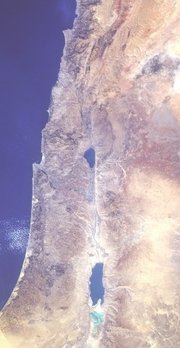Jordan River
|
|
- This article is about the Jordan River in western Asia. For other meanings, see Jordan River (disambiguation).
The Jordan River is a river in Southwest Asia flowing through the Jordan Rift Valley into the Dead Sea. It arises from springs at the base of Mount Hermon. One spring forms the stream Nahal Senir, the second (Banaias at Caesarea Philippi) forms the stream Naahal Hermon, the third forms the stream Nahal Dan, all three of which merge to form the Jordan. The Jordan drops rapidly in a seventy-five kilometer run to swampy Ha-Hula Lake, which is slightly below sea level in the Rift Valley. Exiting the lake, it drops much more in about 25 kilometers to the Sea of Galilee, also known as Kinnereth. The last section has less gradient, and the river begins to meander before it enters the Dead Sea, which is about 400 meters below sea level and has no outlet. Two major tributaries enter from the east during this last phase, the Yarmouk River and Jabbok River.
Its section north of Sea of Galilee is within the boundaries of Israel. South of the lake, it forms the border between the kingdom of Jordan (to the east) and Israel (to the west). Further south, it forms the border between Jordan and the West Bank.
In modern times the waters are 70 to 90 per cent used for human purposes and the flow is much reduced. Because of this and the high evaporation rate of the Dead Sea, the sea is shrinking. All the shallow waters of the southern end of the sea have been drained in modern times and are now salt flats.
The waters of the Jordan are an extremely important resource to the dry lands of the area and are a bone of contention between Lebanon, Syria, Jordan, Israel and the Palestinians.
In the Bible
In the Hebrew Bible, the Jordan is referred to as the source of fertility to a large plain ("Kikkar ha-Yarden"), called on account of its luxuriant vegetation "the garden of God" (Genesis 13:10). There is no regular description of the Jordan in the Bible; only scattered and indefinite references to it are given. Jacob crossed it and its tributary, the Jabbok (the modern Al-Zarḳa), in order to reach Haran (Gen. 32:11, 23-24). It is noted as the line of demarcation between the "two tribes and the half tribe" settled to the east (Num. 34:15) and the "nine tribes and the half tribe of Manasseh" that, led by Joshua, settled to the west (Josh. 13:7, passim).
Opposite Jericho it was called "the Jordan of Jericho" (Num. xxxiv. 15, xxxv. 1). The Jordan has a number of fords, and one of them is famous as the place where many Ephraimites were slain by Jephthah (Judges 12:5-6). It seems that these are the same fords mentioned as being near Beth-barah, where Gideon lay in wait for the Midianites (Judges 7:24). In the plain of the Jordan, between Succoth and Zarthan, is the clay ground where Solomon had his brass-foundries (I Kings 7:46).
In Biblical history the Jordan appears as the scene of several miracles, the first taking place when the Jordan, near Jericho, was crossed by the Israelites under Joshua (Josh. iii. 15-17). Later the two tribes and the half tribe that settled east of the Jordan built a large altar on its banks as "a witness" between them and the other tribes (Josh. xxii. 10, 26 et seq.). The Jordan was said to be crossed dry-shod by Elijah and Elisha (II Kings 2: 8, 14). Elisha performed two other miracles at the Jordan: he healed Naaman by having him bathe in its waters, and he made the ax of one of the children of the prophets float, by throwing a piece of wood into the water (II Kings 5:14, 6:6).
The Jordan was crossed by Judas Maccabeus and his brother Jonathan during their war with the Nabatæans (I Macc. 5:24). A little later the Jordan was the scene of the battle between Jonathan and Bacchides, in which the latter was defeated (I Macc. 9:42-49).ar:أردن (نهر) bg:Йордан bn:জর্দান নদী de:Jordan fr:Jourdain he:ירדן (נהר) it:Giordano nl:Jordaan (rivier) ja:ヨルダン川 pt:Rio Jordão sa:जार्दन नदी sv:Jordan wa:Djordin (aiwe) zh:约旦河

